Quick-Start Guide for Logic Pro X AU ARA
- Quick Start for Logic Pro and DAWs using AU Plug-ins
- Two Plug-in Versions
- Installation and Initial Setup
- Using the ARA version of VocAlign 6 Pro
- Adding Vocalign 6 Pro to your tracks
- The plugin window and link settings
- Removing Vocalign
- Processing your Guide and Dub
- Select a preset and Capture your Dub
- Further controls
- Processing a Harmony Track
- Fixing Problems
- Previous Next
Quick Start for Logic Pro and DAWs using AU Plug-ins
Overview
In this Quick Start Guide you will learn how to set up Logic Pro and VocAlign 6 Pro to transfer audio into VocAlign 6 Pro, process the audio, and have the processed output returned to Logic Pro. Other DAWs using AU plug-ins should have similar workflows.

|
Ableton Live users: Do NOT use the AU version of VocAlign 6 Pro, use the VST3 Real-Time Capture Version. Click here to go to instructions. |
The procedure might seem a little complex at first because you have to tell the plug-in which track contains the Guide and which track(s) need their timing and/or pitch adjusted by VocAlign 6 Pro to match the Guide's.
In this Quick Start Guide, we won’t go into details about the control panels or displays, since those are described in the "Using VocAlign 6 Pro" sections.
One last note - because we started long ago in the film industry, we call the audio to be modified a “Dub”.
Two Plug-in Versions
VocAlign 6 Pro installs two versions of the Audio Unit (AU) plugin used by Logic Pro X (and some other DAWs):
- VocAlign 6 Pro AU (ARA) - which only runs in Logic Pro X 10.7 or later. Please note that ARA is not supported by Logic on Apple Silicon MAC computers.
VocAlign 6 Pro AU (Real-time capture) - which runs in Logic Pro 10.5 and later.
Installation and Initial Setup
- You should have already downloaded, installed and authorised the VocAlign 6 Pro plug-in on your Mac computer.
See Installation and Authorization if you haven't done this.
- It’s also necessary to make Logic's track selection automatically follow the selection of audio regions.
- This may already be set up, but if not, in Logic Pro, open Preferences > General, and select the Editing tab at the top.
- In the Editing page, enable ‘Select tracks on Region/Marquee selection’.
Using the ARA version of VocAlign 6 Pro
 | If you’re using an Apple Silicon Mac, rather than an Intel-powered model, you’ll currently need to switch Logic to Rosetta Mode to use the VocAlign 6 Pro AU (ARA) plugin. To do this, right-click the Logic Pro application in your Mac’s Applications folder, select Get Info, and check the ‘Open using Rosetta’ checkbox. |
IMPORTANT OPERATIONAL NOTE FOR USING LOGIC PRO WITH ARA PLUG-INS
- VocAlign will quickly start and stop playback each time the Capture button is pressed, before initiating the capture of audio. This will create a short burst of playback.
- This ensures that VocAlign 6 Pro AU (ARA) (and all other ARA plugins) are updated correctly.
- This is a requirement of Logic Pro rather than a design decision of Synchro Arts.
- If needed, you can manually update all ARA plugins by simply tapping the Spacebar twice to start and stop playback before you press either Capture button in VocAlign 6 Pro.
Adding Vocalign 6 Pro to your tracks
In Logic Pro, we will add VocAlign 6 Pro as an insert on any track that contains audio that we would like to work with. For this guide, we have two tracks to work with:
- Lead Vocal GUIDE: our main vocal track, referred to as our Guide
- Double Vocal DUB: our vocal double, or Dub, that we would like to tune and align to our Guide track

To add VocAlign to our tracks, we will click the 'Audio FX' slot in the inspector on the left side of the Logic Pro interface. If you do not see the inspector, you can go to 'Help' and type 'inspector' in the search bar. Select 'Show Inspector' from the results.
Once you've clicked the 'Audio FX' slot circled in red below, choose VocAlign from the menu as indicated by the red arrows in the below image. VocAlign is available under 'Audio Units -> Synchro Arts -> VocAlign 6 Pro AU (ARA) -> Mono'. VocAlign may also be available in the 'Recent' section of the menu.
Repeat this process for both your Guide and Dub tracks.
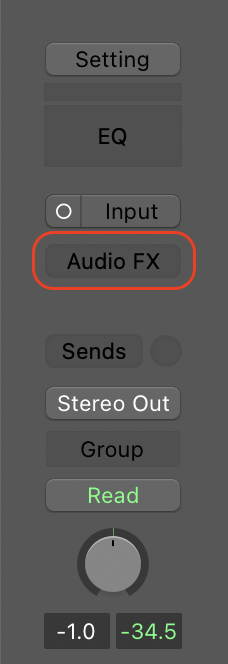 ... then ...
... then ... 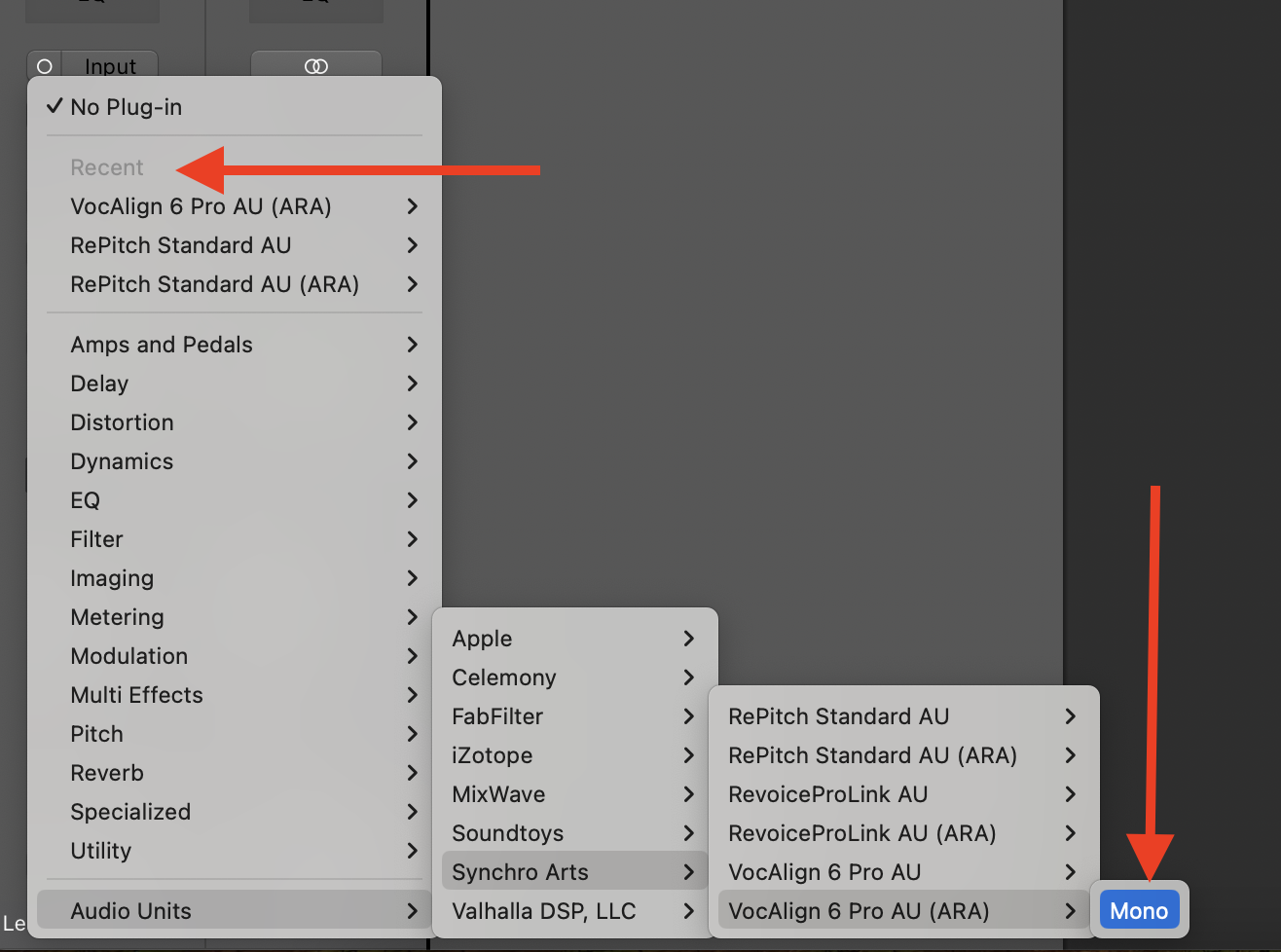
The plugin window and link settings
Now that the plugin window is open, you should see something similar to the below image.
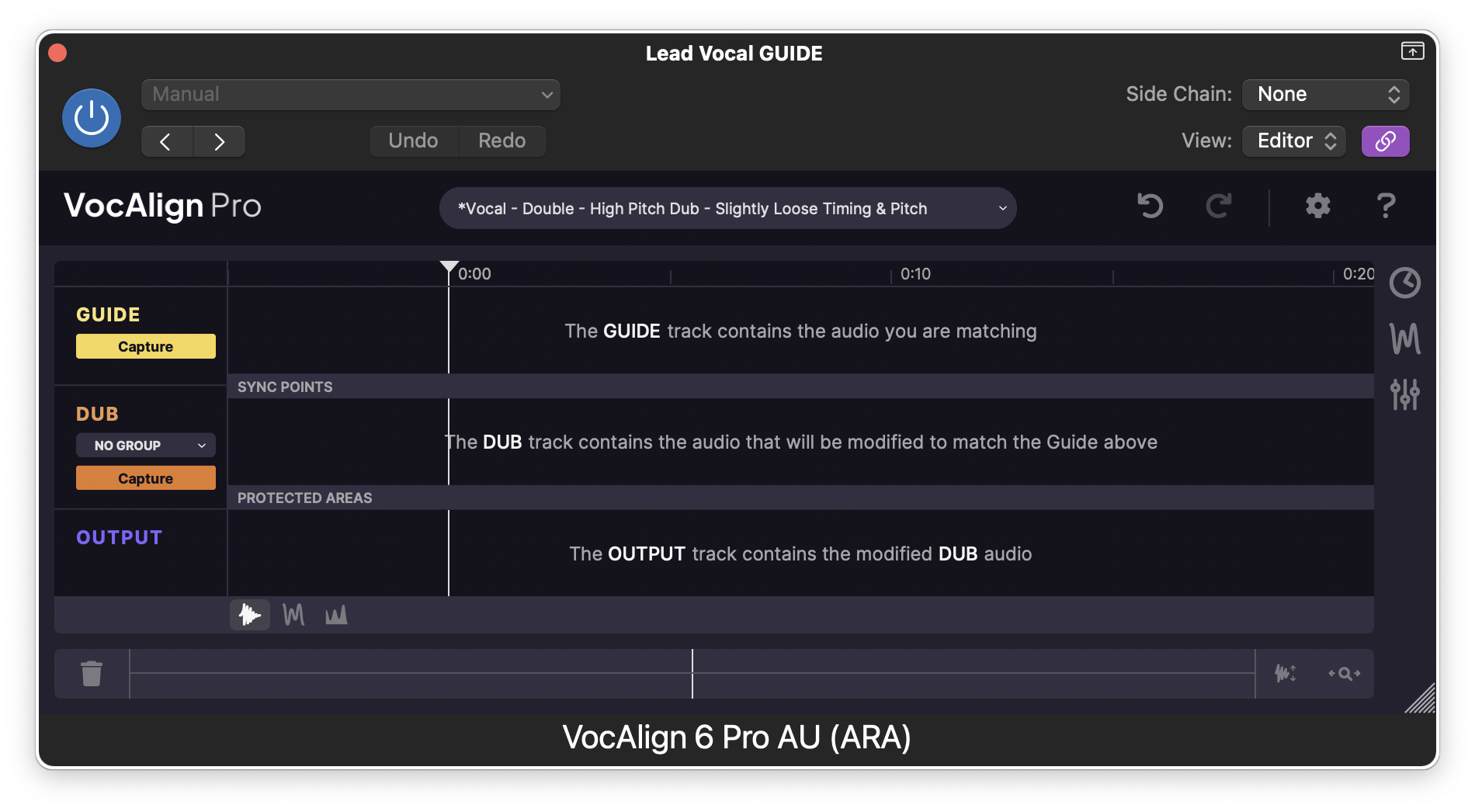
Before continuing, we will make sure to set the 'Link' setting in our plugin window to Multi. This setting is available in the top right corner of the plugin window and looks like to chain links, circled in red in the below image. The button should be purple, indicating Multi mode. If it is not, click it to change the Link setting.

If you cannot see this control, click the small icon in the top right corner of your plugin window, indicated below.
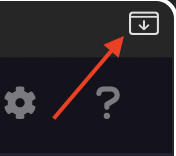
Removing Vocalign
If you need to remove VocAlign from a track, click the Audio FX slot that contains VocAlign, and select 'No Plugin' from the menu.
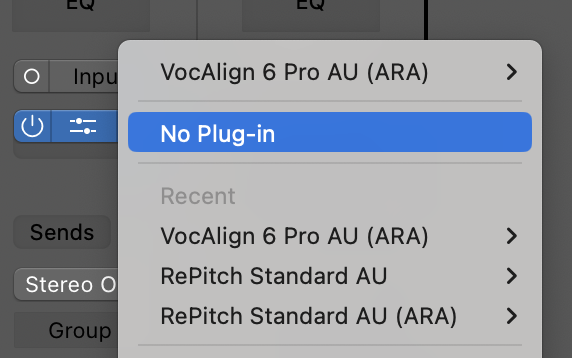
Processing your Guide and Dub
We will now Capture our Guide into VocAlign.
First, select your Guide audio region as shown in the below image.
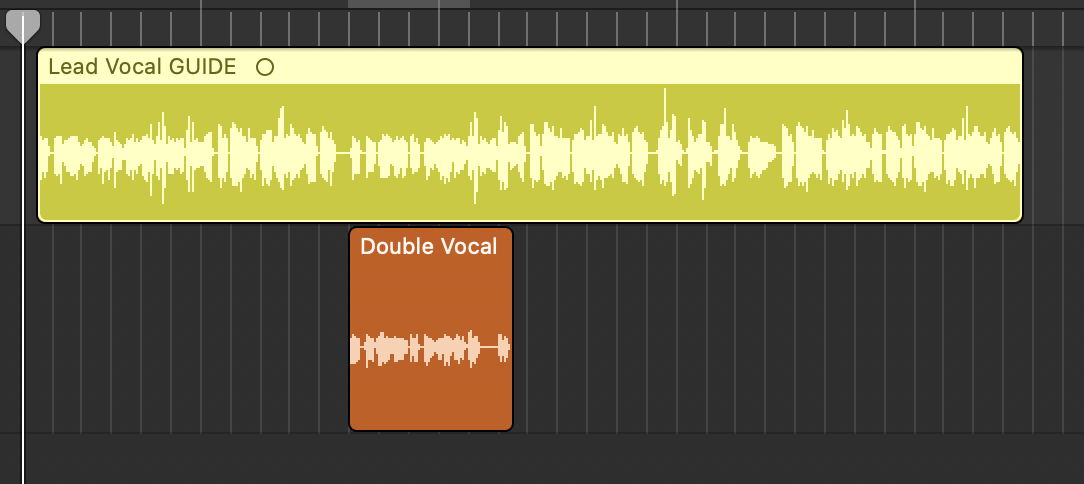
Second, in VocAlign, press the yellow Capture button underneath 'Guide' as indicated by the red arrow in the below image. This will Capture your audio into the Guide area of the VocAlign interface, which now displays a yellow waveform. The outline of the Guide waveform is also shown in the Output track as a timing reference.
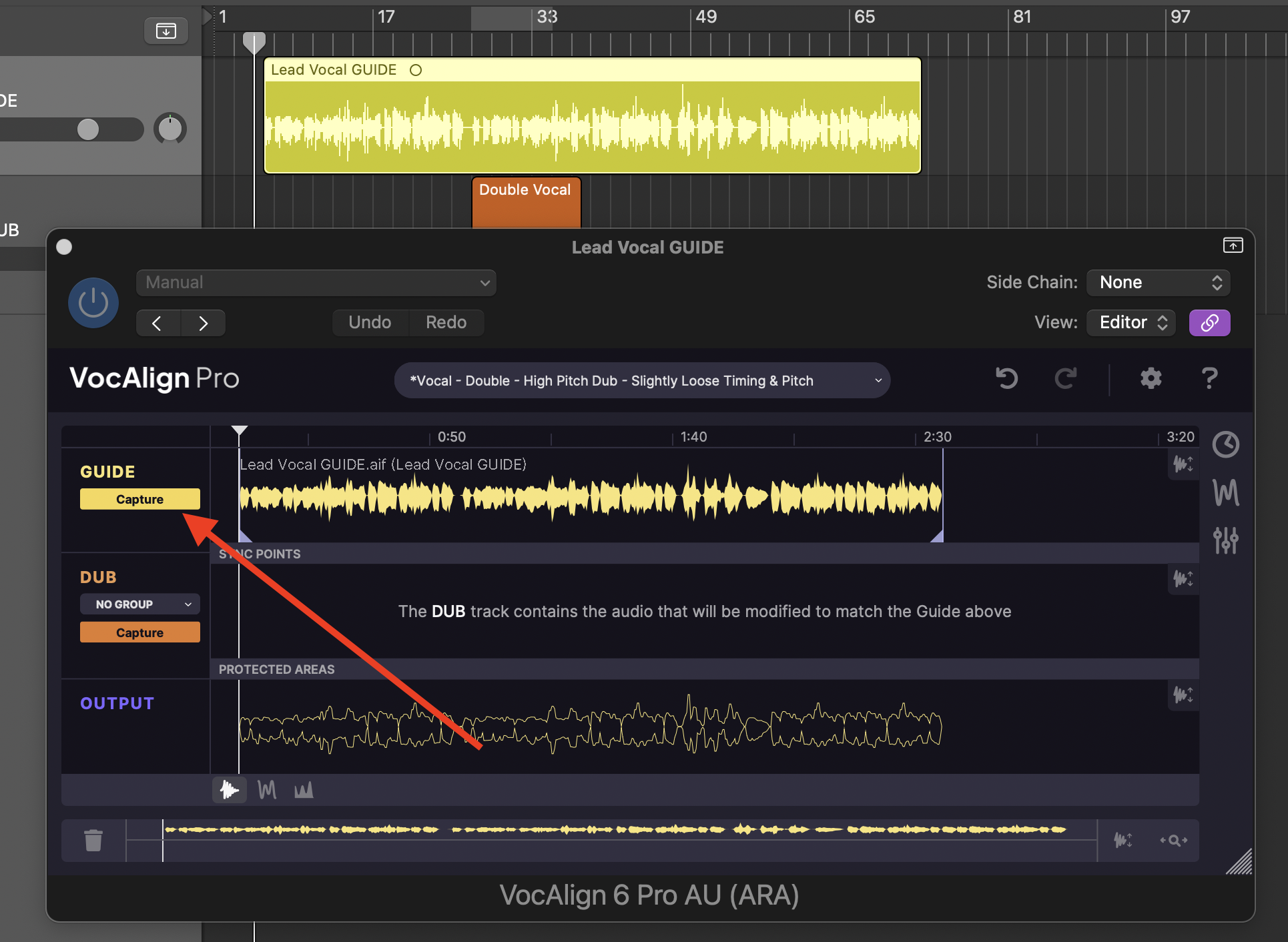
Our Guide audio is now ready to use in VocAlign.
Select a preset and Capture your Dub
Before capturing our Dub, we will select a preset. Once the Dub is captured, VocAlign will immediately process and output it with whatever preset is currently selected. The preset menu is at the centre-top of the VocAlign interface, shown below.

Click the preset to open a dropdown menu. Our Dub track is a vocal in a high range, so we will select 'Vocal -> Double -> High Pitch Dub -> Slightly Loose Timing & Pitch' as indicated below.
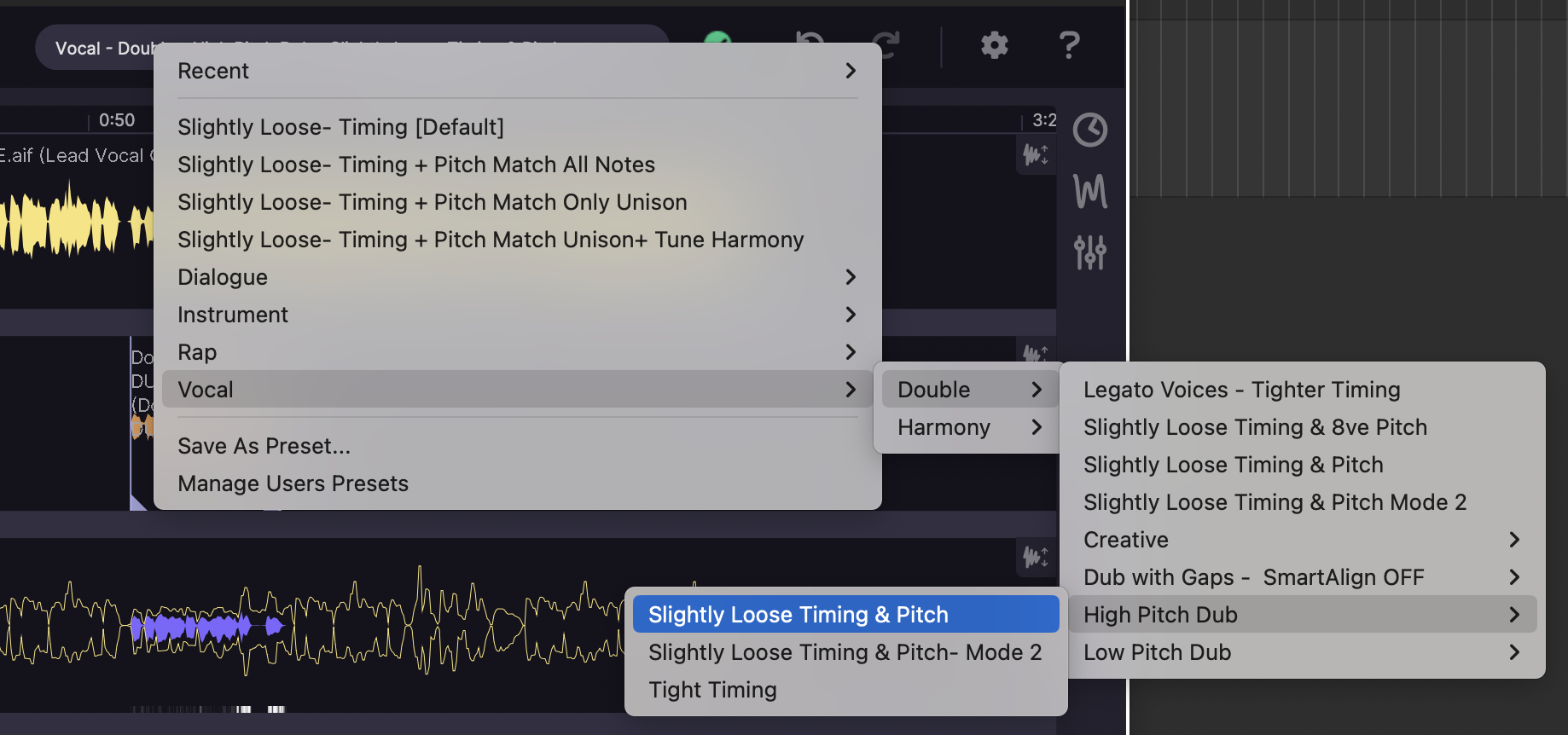
Next, ensure that VocAlign has been added to your Dub track in the Audio FX slot as described above.
Now select your Dub audio region, as shown below.
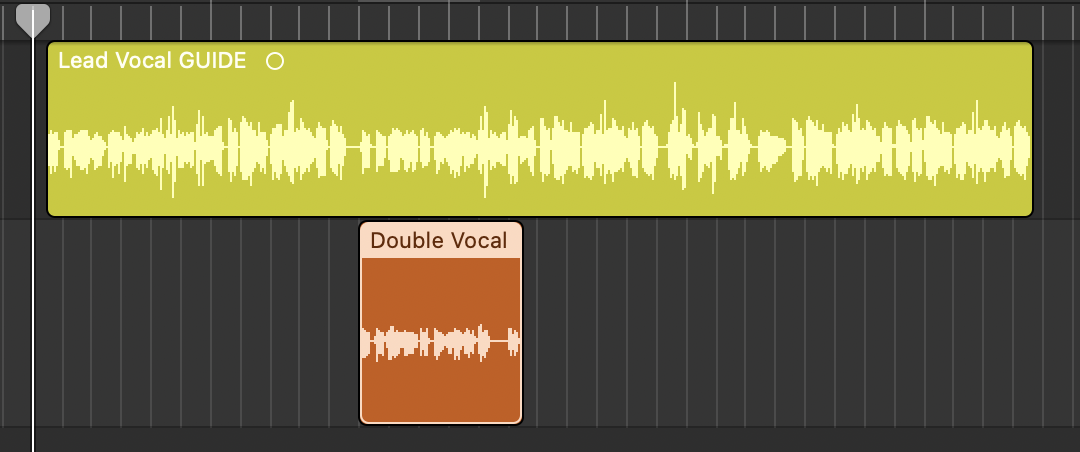
Within VocAlign, click the orange Capture button under Dub, as indicated by the red arrow in the below image. You will now see an orange waveform in the Dub section of VocAlign, indicating our Dub audio.
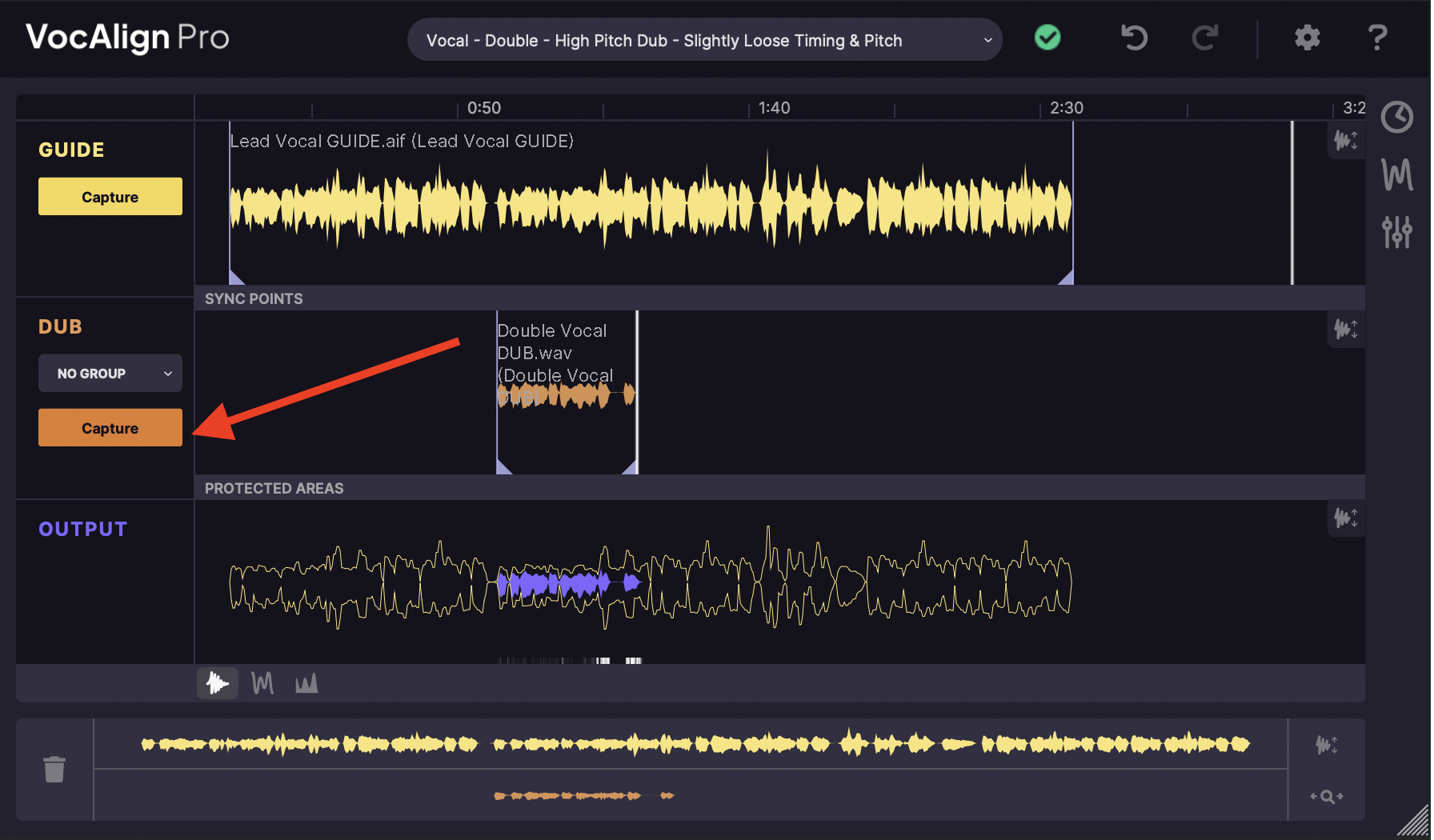
VocAlign immediately applies our chosen preset and processes our Dub track to create the purple Output shown just below the dub. Because we are using ARA, we can also play back our processed audio directly in Logic to hear the resulting output.
Rendering your output
If you would like to render and commit your changes, you can use Logic's Bounce In Place command. Right click the region you would like to render, and select 'Bounce and Join -> Bounce In Place' from the menu. You can also use Ctrl + B.
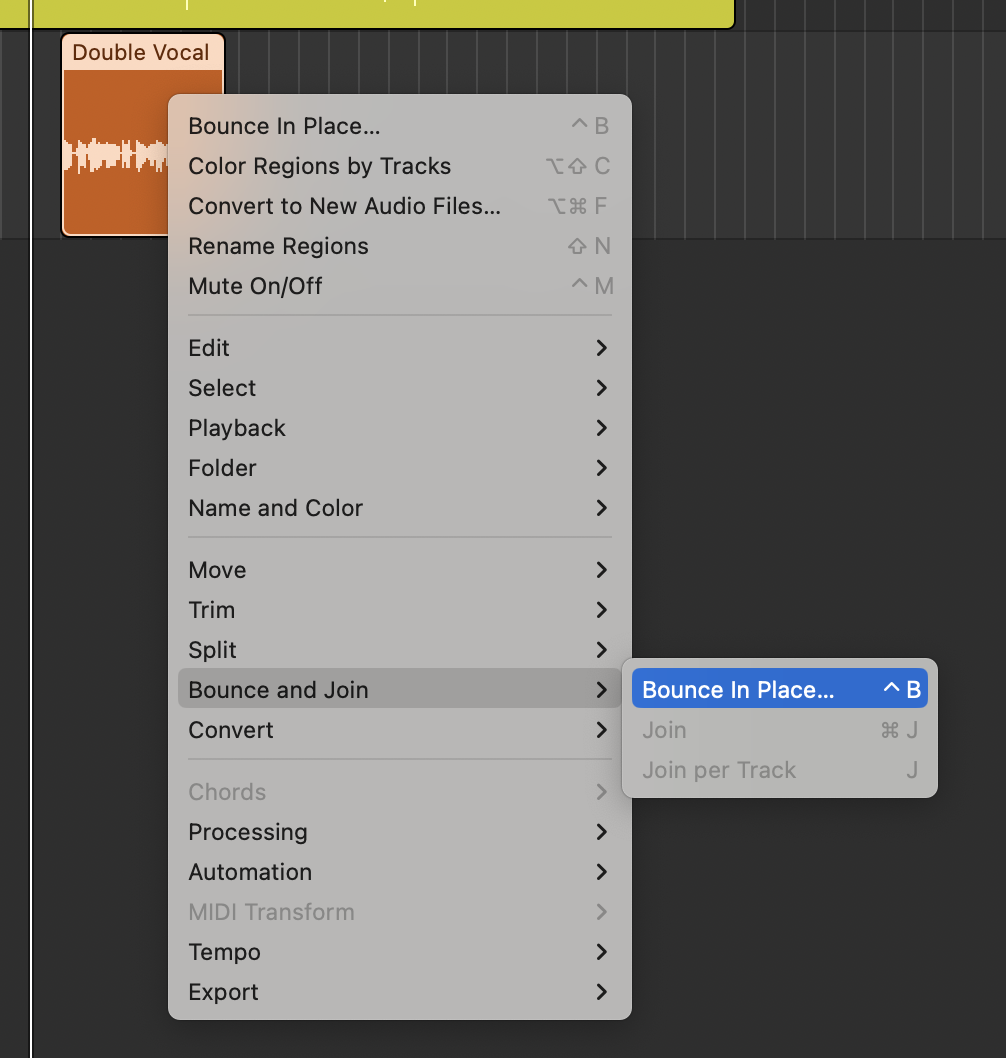
This will open the below dialogue box, where you can choose what you would like Logic to do with the resulting audio.
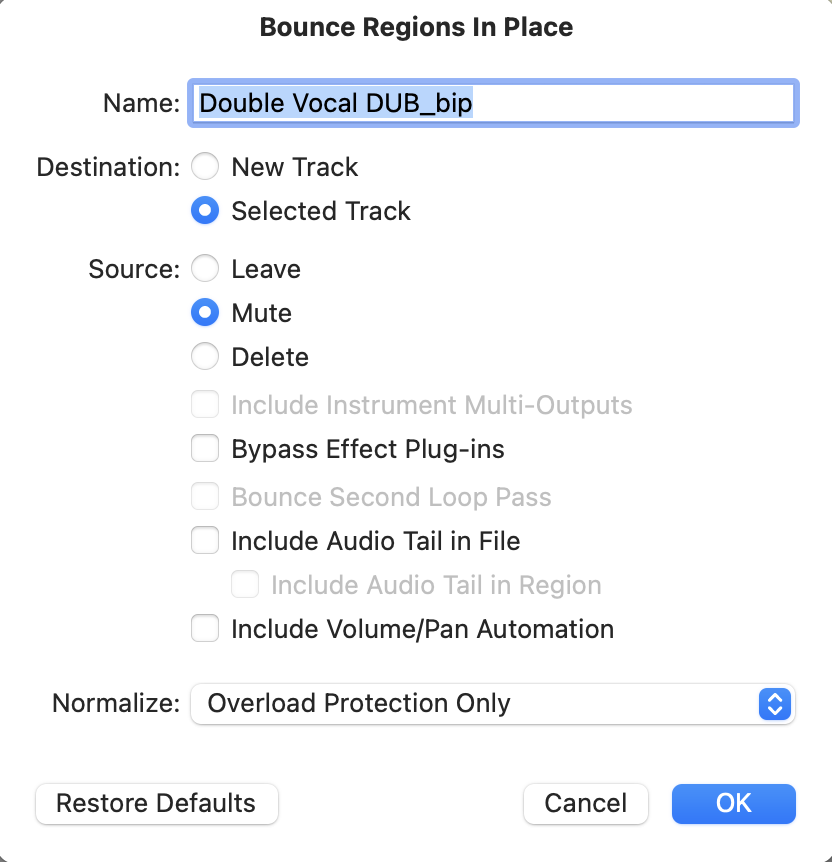
Further controls
Vocalign also provides in-depth control via the Pitch, Timing, and Other control panels available on the right side of the UI. These controls are discussed in detail here.
To open these panels, click the three icons on the right side of the interface, circled in red below.
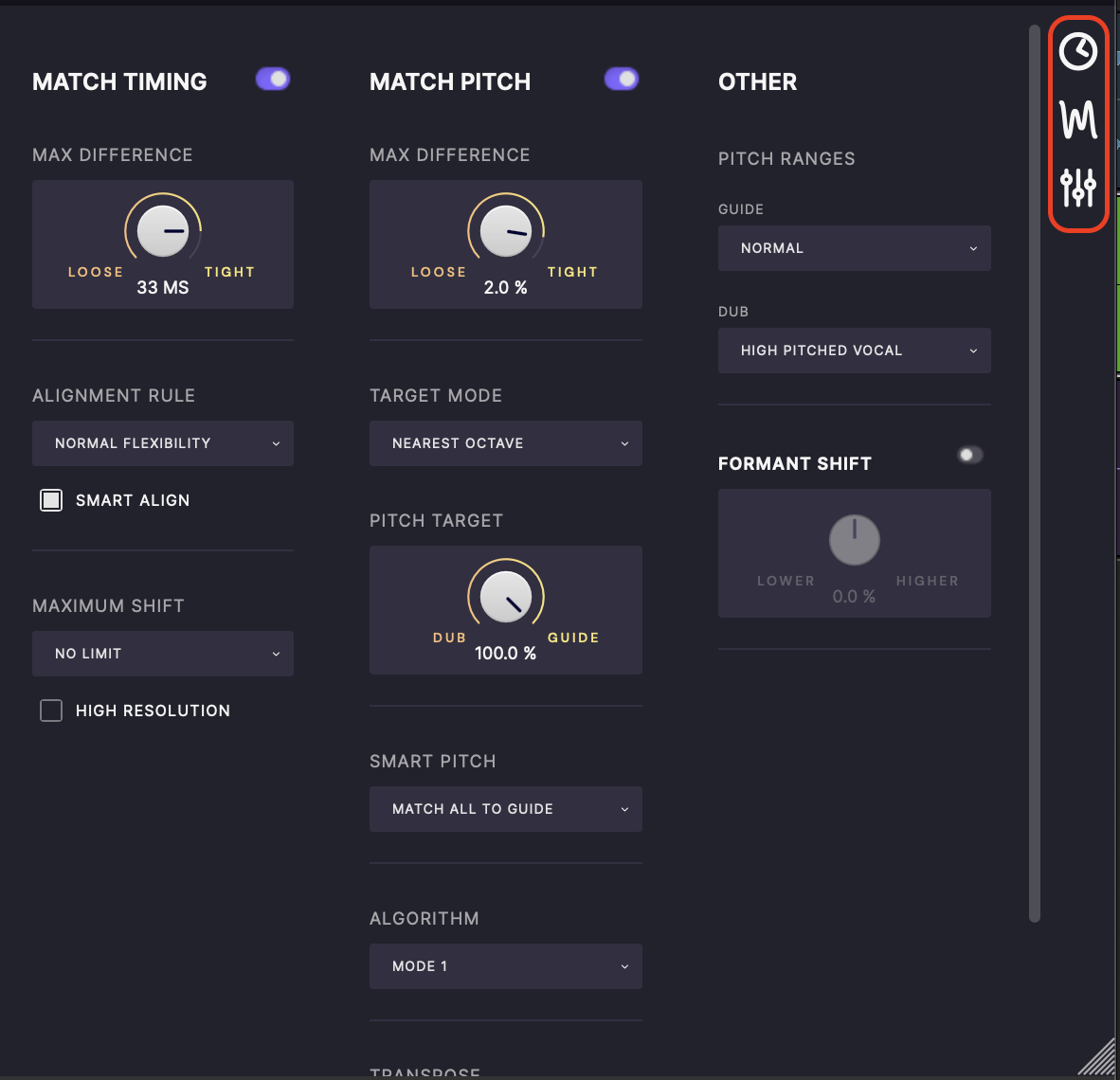
You can adjust the Max Difference controls in the Match Timing and Match Pitch sections to tighten or loosen the timing and pitch alignment applied by the preset. With each change, the Output is reprocessed and the Output waveform redrawn, and the audio is synched to Pro Tools via the ARA connection.
Processing a Harmony Track
When working with harmonies, Vocalign provides Smart Pitch. The Smart Pitch options are accessed in the 'Match Pitch' control panel, discussed in detail here.
Fixing Problems
Protected Areas
There will be times when you want to exclude certain sections in the Dub from processing – when your Guide vocal jumps up an octave, or gets raspy and lower, but your Dub doesn't, for example. Or when there are different words or syllables in the Guide and Dub, which can throw the time alignment off, resulting in unnatural distortion of the Output timing. VocAlign 6 Pro's Protected Areas enable pitch, time or both to be kept unprocessed over any specified range within the Dub.
Protected areas are covered in detail here.
Sync Points
If you're getting small differences in timing caused by different words, sounds or delivery, you can correct them using Sync Points. These let you assign pairs of pointers to events in the Guide and Dub that should be time aligned if they are not. Click here for more details on Sync Points and how to use them.
PreviousNext